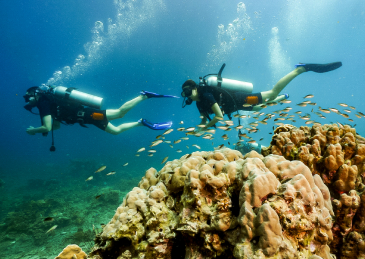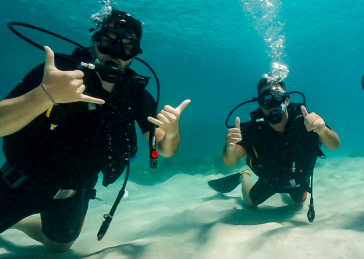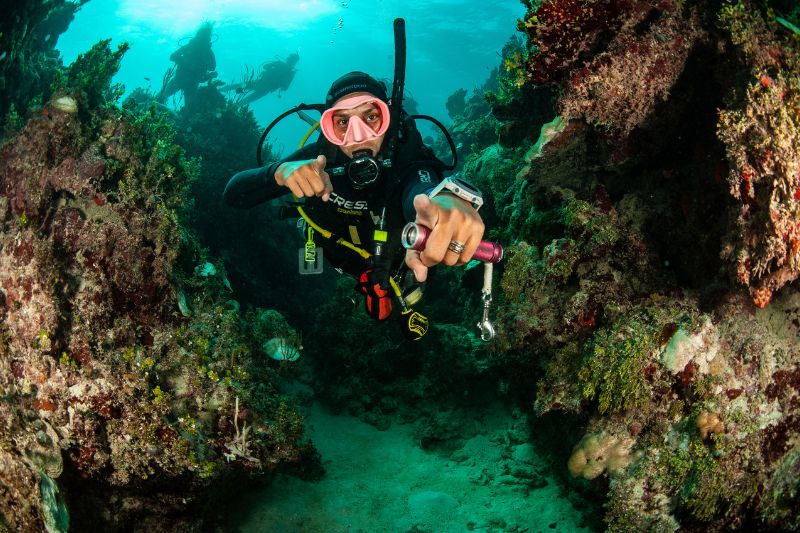21st April 2025
Main Points
For experienced divers, solo diving in Koh Tao offers unmatched independence and self-sufficiency.
Optimal diving conditions in Koh Tao are typically between March and September.
Key gear for solo diving includes a dive computer, redundant (or extra air) supply, and a surface marker buoy.
Successful solo diving requires strong navigational skills and emergency management.
Get to know the marine life of Koh Tao, which includes colorful coral reefs and a variety of fish species.
Start Your Solo Diving Journey in Koh Tao
“pony bottle …” from scubaboard.com and used with no modifications.
Welcome to the Underwater World of Koh Tao
Located in the Gulf of Thailand, Koh Tao, also known as “Turtle Island,” is a treasure trove of over 30 dive sites, all with their own unique underwater topography. Whether you’re interested in shallow coral gardens or deep pinnacles brimming with marine life, Koh Tao has something to offer every diver. The island’s warm waters and exceptional visibility make it an ideal diving location all year round.
Why Dive Solo?
Diving solo is not for everyone, but for experienced divers, it can be an amazing experience. It gives you the freedom to dive at your own speed, without the need to keep up with a buddy. This freedom can lead to a deeper bond with the underwater world, as you rely solely on your abilities and instincts. If you’re considering advancing your skills, you might want to explore the best divemaster courses in Koh Tao.
Additionally, solo diving is a great way to build self-reliance and decision-making skills. You’ll become adept at managing your own dive plan, navigating underwater, and dealing with any problems that come up. This independence can make your diving experience even better and give you a confidence boost, whether you’re in the water or on dry land.
Experience the Liberty and Autonomy
One of the most exhilarating aspects of solo diving is the liberty it affords. You have the power to select your dive sites, plan your timetable, and devote as much time as you desire to investigating the marine marvels. Without the limitations of a buddy, you can remain at a specific location or proceed at your leisure.
How to Plan Your Solo Diving Adventure in Koh Tao
“Trips For Single Divers: Solo Diver …” from www.dresseldivers.com and used with no modifications.
“A successful solo dive hinges on thorough dive planning, understanding your personal limitations, and preventing accidents.”
When it comes to successful solo diving in Koh Tao, planning is everything. Before you take the plunge, you need to do your homework on the dive sites and get to know the local conditions. This will allow you to pick the sites that are the best fit for your skill level and what you’re interested in.
When getting ready for your solo dive, think about things like the temperature of the water, the currents, and how well you can see in the water. These conditions can change depending on the time of year, so you should always look at the most recent reports and talk to the local people who run the dives.
Picking the Perfect Time to Dive
The ideal time to dive in Koh Tao falls between March and September. In these months, the waters are tranquil, and visibility is superb, enabling you to enjoy the island’s colourful marine life to the fullest. But you can still dive for the remainder of the year, as long as you keep an eye on the weather conditions.
Getting to Know Koh Tao’s Underwater Creatures
Koh Tao is a haven for a wide range of sea creatures, from vibrant reef fish to gracefull sea turtles and majestic whale sharks. When you dive alone, you can take your time and get a good look at these animals. Some of the species you’re likely to see are butterflyfish, angelfish, and parrotfish.
Besides fish, Koh Tao’s waters are bursting with colorful coral gardens. These underwater ecosystems offer a haven and food for many marine species. As you explore, make sure to admire the complex beauty of the coral formations and the life they sustain.
Staying Safe While Diving Alone
Diving alone requires you to be extra aware and disciplined. It’s important to follow safe diving practices to stay safe underwater. One of the most important things is to have a good dive plan. Before you get in the water, make sure you know the dive site well and have a clear idea of where you’re going and how deep.
Furthermore, always let someone on shore know about your dive plan, including when you expect to return. This way, if anything goes wrong, someone will know and can take necessary steps. Also, it’s crucial to carry out a pre-dive safety check to make sure all your gear is working correctly.
Must-Have Equipment for Solo Diving
“PADI Self-Reliant Scuba Diver Course” from store.padi.com and used with no modifications.
When diving alone, it is crucial to have the right gear. You can’t depend on a buddy for help when solo diving, so you must be entirely self-sufficient. This means you need to be equipped to deal with any potential situation. If you’re considering advancing your skills, you might want to explore becoming a divemaster to enhance your self-sufficiency underwater.
Essential Equipment You’ll Need
Dive Computer: This is a must-have for keeping track of your depth and dive time to prevent decompression sickness. It is best to carry 2 computers in case one fails.
Spare Mask: This is essential if something happens to your main mask during a dive.
Backup Air Source: Always have an extra source of air, like a pony bottle or sidemount tank, in case your primary tank fails.
Surface Marker Buoy (SMB): This will help you signal your location to boats and other divers.
Dive Knife: This can be handy for cutting through any entanglements or fishing lines.
Underwater Compass: This is crucial for navigation, particularly in conditions with low visibility.
Besides these necessities, think about bringing a whistle or a signaling device to draw attention in the event of an emergency. The aim is to be ready for anything, so you can dive with assurance and tranquility.
Why Dive Computers are Essential for Solo Diving
For solo divers, dive computers are a must-have. They give you up-to-the-minute information about your dive profile, such as depth, bottom time, and decompression status. This data is vital for making smart decisions while you’re underwater.
When choosing dive computers, make sure they have a user-friendly interface, backlighting for low visibility, and a sturdy build to withstand harsh conditions. Some high-end models even offer integrated air management systems, which can be especially handy for solo divers.
Why You Need Redundant Systems
Redundancy is crucial in solo diving. You won’t have a buddy to depend on, so you need to have backup systems. This means carrying a secondary air supply, like a pony bottle or sidemount tank, and having extra essential equipment like dive lights and cutting tools.
Having redundant systems means that if one piece of equipment fails, you have a backup. This not only increases your safety but also your confidence, allowing you to concentrate on the dive itself rather than possible equipment problems.
Perfecting the Art of Solo Diving
“Scuba Diving: Self Reliant/ Solo Diving …” from www.whitestarquarry.com and used with no modifications.
Unlike traditional buddy diving, solo diving requires a different set of skills. You have to be able to manage your dive from beginning to end, including navigation, buoyancy control, and handling emergencies.
Handling Emergencies Solo
Arguably the most difficult part of solo diving is managing emergencies. Without a buddy to help, you must be prepared to handle situations on your own. This means you must be skilled in self-rescue techniques, such as freeing yourself from entanglements or performing an emergency ascent.
Keeping cool under pressure is also a key skill. Panic can make a bad situation worse and lead to bad decisions. By rehearsing emergency scenarios and building your confidence, you can improve your ability to handle surprises underwater. For those who might need a refresher, consider looking into scuba refresher courses to enhance your skills.
Performing Safety Checks Before Diving
“Scuba Diving Buddy Checks – Empty Nest …” from emptynestdiver.com and used with no modifications.
When you are planning a solo dive, it is crucial to perform a comprehensive pre-dive safety check. This is to make sure all your equipment is working properly and you are ready for any situation. Start by examining your dive gear, such as your regulators, BCD, and dive computers. Look for any signs of wear or damage that could put your safety at risk.
Then, check that you have enough air and that your tanks are filled to the correct pressure. Make sure your buoyancy control device (BCD) is working properly by testing that it inflates and deflates as it should. If your BCD isn’t working properly, it could make it hard to control your buoyancy, which is important for a safe dive.
Common Questions
If you’re getting ready for your solo diving trip to Koh Tao, you might have a lot of questions. Here are some of the most common questions to help you plan your trip:
When is the ideal time to go diving in Koh Tao?
March to September is the optimal time for diving in Koh Tao. The weather is typically calm during these months, and visibility is at its best, allowing you to fully enjoy the lively marine life. However, you can dive all year round, so you can plan your trip based on your availability.
Is solo diving risky?
Yes, solo diving is risky, mainly because you lack a buddy who can help in an emergency. But you can reduce these risks by being well-prepared and following safe diving procedures. This includes carrying the right equipment, performing comprehensive pre-dive checks, and being skilled in self-rescue methods.
Is solo diving in Koh Tao suitable for beginners?
Generally, solo diving is not advised for beginners. It demands a significant amount of experience and self-assurance in the water. The majority of diving institutions recommend that divers have a minimum of 100 recorded dives and advanced certifications before attempting solo dives. Before diving solo, it’s critical to have a thorough understanding of dive planning, navigation, and emergency management.
What kind of marine life will I see if I dive alone?
The variety of marine life in Koh Tao makes it a diver’s dream. If you dive alone, you’ll likely see bright reef fish like butterflyfish, angelfish, and parrotfish. The coral gardens on the island are full of life and provide a home for many species.
Not only will you see fish, but you might also come across bigger sea creatures like sea turtles and whale sharks. These encounters can be extremely satisfying, giving you the opportunity to bond with the sea’s inhabitants on a personal level.
Can you solo dive at all of the dive sites in Koh Tao?
Solo diving is usually allowed at the majority of dive sites in Koh Tao, but it’s important to check the local rules and guidelines. Certain sites may have particular restrictions.
Moreover, you should take into account both the conditions of the site and your own level of skill before you embark on a solo dive. Some sites might have strong currents or difficult terrain, both of which could present extra risks for those diving alone. You should select sites that are commensurate with your level of experience and comfort in order to guarantee a safe and pleasurable dive.
By adhering to local regulations and selecting the right dive sites, you can experience the thrill and adventure of solo diving while ensuring your safety and preserving the natural beauty of Koh Tao.
Dive with LBD: Your Gateway to Underwater Exploration
Whether you’re a curious beginner or a seasoned pro, our school is your portal to the wonders of scuba diving. Join us into the world beneath the waves.
READY TO GET STARTED?
Check our diving courses in Koh Tao








